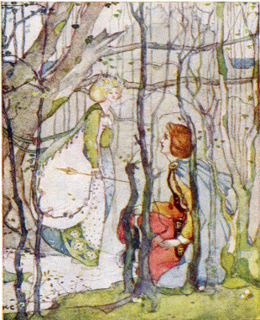| Wikisource has original text related to this article: |
"The Wee Wee Man" is Child ballad number 38, existing in several variants. [1]
| Wikisource has original text related to this article: |
"The Wee Wee Man" is Child ballad number 38, existing in several variants. [1]
The narrator meets with a wee, wee man. He lifts an enormous stone and throws it, and she thinks that if she were as strong as Wallace, she could have lifted it to her knee. She asks him where he lives, and he has her come with him to a hall where there is a lady, sometimes explicitly called the fairy queen, and her ladies, usually twenty-four and so beautiful that the ugliest would make a fit queen of Scotland, but they, and the wee, wee man, instantly vanish.
Steeleye Span included it in the 1973 album Parcel of Rogues .
Danish composer Vagn Holmboe set the ballad to music twice, for tenor and small orchestra in 1971 (as op. 107b), and for mixed choir a cappella in 1972 [2]
This ballad was one of 25 traditional works included in Ballads Weird and Wonderful (1912) and illustrated by Vernon Hill.

Sir Thomas de Ercildoun, better remembered as Thomas the Rhymer, also known as Thomas Learmont or True Thomas, was a Scottish laird and reputed prophet from Earlston in the Borders. Thomas' gift of prophecy is linked to his poetic ability.
TamLin is a character in a legendary ballad originating from the Scottish Borders. It is also associated with a reel of the same name, also known as the Glasgow Reel. The story revolves around the rescue of Tam Lin by his true love from the Queen of the Fairies. The motif of capturing a person by holding him through all forms of transformation is found throughout Europe in folktales.
Vagn Gylding Holmboe was a Danish composer and teacher who wrote largely in a neo-classical style.
"The Bonnie Earl o' Moray" is a popular Scottish ballad, which may date from as early as the 17th century.
Sir Aldingar is Child ballad 59. Francis James Child collected three variants, two fragmentary, in The English and Scottish Popular Ballads. All three recount the tale where a rebuffed Sir Aldingar slanders his mistress, Queen Eleanor, and a miraculous champion saves her.
"Allison Gross" is a traditional ballad, catalogued as Child Ballad #35. It tells the story of "the ugliest witch in the north country" who tries to persuade a man to become her lover and then punishes him by a transformation.

"Hind Horn" is a traditional English and Scottish folk ballad.
Fair Annie is Child ballad number 62, existing in several variants.
The Laird O Logie or The Laird Of Logie is Child ballad number 182.
"Young Waters" is Child ballad number 94.
Fause Foodrage is Child ballad 89, existing in several variants.
The Queen of Scotland is a folk song.
"Gil Brenton" is Child ballad 5, Roud 22, existing in several variants.
Crow and Pie is Child ballad 111. It is one of the oldest preserved ballads, dating to c. 1500. Pie is the now-obsolete original name for the magpie, a bird often connected with sorrow and misfortune. The crow is a scavenger, often thought of as feeding upon the bodies of men hanged or slain in battle, and thus associated with unhallowed and violent death.
"Proud Lady Margaret" is Child ballad 47, existing in several variants.
"Blancheflour and Jollyflorice" is a traditional ballad from Great Britain; it is included in a collection published as The English and Scottish Popular Ballads between 1882 and 1898 by Francis James Child. "Blancheflour and Jollyflorice" is included in the collection as Child ballad 300. Its Roud number is 3904.
"Wee Cooper O'Fife" is a Scottish folk song about a cooper who has "a braw new wife" who will not cook, clean, and sew in case she "spoil her comely hue". A town in Fife is called Cupar; this is a pun.
The (Bonnie) Rantin' Laddie or Lord Aboyne is a traditional Scottish folk ballad telling of the valiant rescue of his lover by a noble Highland lord.
Queen of Elphame or "Elf-hame", in the folklore belief of Lowland Scotland and Northern England, designates the elfin queen of Faerie, mentioned in Scottish witch trials. She is equivalent to the Queen of Fairy who rules Faërie or Fairyland. The Queen, according to testimony, has a husband named "Christsonday".
Thomas o Yonderdale is Child ballad number 253; Roud number 3890. Child assessed that this "apocryphal" ballad seemed like a recent fabrication from a pastiche of other ballads.
| This folk song–related article is a stub. You can help Wikipedia by expanding it. |